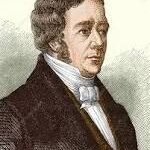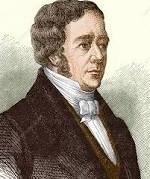Hans Christian Ørsted (1777-1851) was a Danish physicist and chemist who discovered that electric currents create magnetic fields, leading to the concept of electromagnetism. This discovery laid the foundation for the development of many technologies, including electrical power generation, motors, and telecommunications. Ørsted is considered one of the founding fathers of electromagnetism along with scientists like Michael Faraday and André-Marie Ampère.
Hans Christian Ørsted Birth
Hans Christian Ørsted was born in Rudkøbing, Denmark, on August 14, 1777.
He was the child out of ten born by Mr. Søren Christian Ørsted and Mrs Karen Hermansen Ørsted. They lived in Rudkøbing, Denmark, where Hans Christian Ørsted was born.
His father, Søren Christian Ørsted, was a pharmacist by profession. His mother, Karen Hermansen Ørsted, was the daughter of a merchant. While Søren Christian Ørsted worked as a pharmacist, he also had interests in natural philosophy, which may have influenced Hans Christian Ørsted’s later pursuits in science.
Hans Christian Ørsted Siblings
Mr. Søren Christian Ørsted children in the order of birth is as follow:
- Anders Sandøe Ørsted (1778–1860)
- Hans Christian Ørsted (1777–1851)
- Jacob Ørsted (1782–1819)
- Christian Ørsted (1783–1843)
- Joachim Ørsted (1785–1854)
- Hans Peter Ørsted (1788–1842)
- Anton Ørsted (1791–1860)
- Anna Ørsted (1792–1837)
- Johan Rudolph Ørsted (1794–1866)
- Karen Margrethe Ørsted (1797–1884)
Hans Christian Early life
From a young age, he showed an interest in science and natural philosophy. He was fortunate to have access to a good education, attending school in Copenhagen and later studying at the University of Copenhagen.
Ørsted initially pursued a degree in medicine, as was common for students of natural philosophy at the time, but his interests soon shifted towards physics and chemistry. He was greatly influenced by the works of scientists like Isaac Newton and Johann Wilhelm Ritter.
After completing his education, Ørsted embarked on a journey of scientific exploration and discovery. He conducted experiments in various fields of physics and chemistry, including acoustics, optics, and electricity. His most famous discovery came in 1820 when he observed that electric currents could create magnetic fields, leading to the development of the concept of electromagnetism.
Throughout his life, Ørsted was deeply engaged in scientific research and education. He held various academic positions, including professorships at the University of Copenhagen, where he inspired numerous students with his passion for science. Ørsted’s contributions to the field of electromagnetism laid the foundation for modern physics and earned him international acclaim.
Beyond his scientific achievements, Ørsted was also involved in cultural and philosophical pursuits. He wrote extensively on topics ranging from aesthetics to the unity of the physical sciences.
Overall, the early life of Hans Christian Ørsted was characterized by intellectual curiosity, a thirst for knowledge, and a relentless pursuit of scientific truth. His groundbreaking discoveries continue to influence scientific research to this day.

Schooling
Hans Christian Ørsted attended various schools during his early education. He began his schooling in Rudkøbing, Denmark, where he was born. Later, he attended the Cathedral School in Horsens, Denmark. After completing his primary education, Ørsted continued his studies at the University of Copenhagen, where he pursued a degree in medicine. While at the university, he became increasingly interested in physics and natural philosophy, eventually leading him to make significant contributions to the field of electromagnetism.
Oersted Marriage
Hans Christian Ørsted married twice in his lifetime.
His first marriage was to Inger Birgitte Ballum on June 1, 1814. They had six children together: two sons, Christian and Carl, and four daughters, Mathilde, Henriette, Charlotte, and Harriet. Sadly, his first wife, Inger, passed away in 1829.
In 1831, Ørsted married his second wife, Magdalene Cathrine Hanck. Their marriage lasted until Ørsted’s death in 1851. He did not have any children with his second wife
His children
Hans Christian Ørsted had six children with his first wife, Inger Birgitte Ballum. These children were born between the years of 1815 and 1828. Their names, in order of birth, were:
- Christian Ørsted
- Carl Ørsted
- Mathilde Ørsted
- Henriette Ørsted
- Charlotte Ørsted
- Harriet Ørsted
There isn’t extensive information readily available about the specific career paths or achievements of Hans Christian Ørsted’s children. However, it’s worth noting that Christian Ørsted, his eldest son, followed in his father’s footsteps to some extent. Christian became a botanist and made contributions to the study of algae
Achievements
Here are some of Hans Christian Ørsted’s key achievements:
Discovery of Electromagnetism
Ørsted discovered the phenomenon of electromagnetism on April 21, 1820, while conducting an experiment at the University of Copenhagen. This discovery demonstrated the relationship between electric currents and magnetic fields.
Publication of “Experiments on the Effect of a Current of Electricity on the Magnetic Needle”:
Ørsted published his findings on electromagnetism in a paper titled “Experiments on the Effect of a Current of Electricity on the Magnetic Needle” in July 1820. This publication provided a detailed account of his experiments and observations.
Demonstration of Electromagnetic Rotation
On September 16, 1820, Ørsted demonstrated that an electric current could produce mechanical motion by causing a wire carrying the current to rotate around a magnetic needle. This experiment further confirmed the connection between electricity and magnetism.
Development of Electromagnetic Theory
Following his initial discovery, Ørsted continued to investigate the relationship between electric currents and magnetic fields. His work contributed to the development of electromagnetic theory, which was further advanced by scientists like André-Marie Ampère and Michael Faraday.
Contributions to Chemistry
In addition to his work in electromagnetism, Ørsted made significant contributions to chemistry throughout his career. He conducted research on the properties of gases and the nature of chemical bonds, contributing to advancements in chemical theory.
Experimental Research
Ørsted was known for his meticulous experimental approach to scientific research. He conducted numerous experiments in various fields, including acoustics, optics, and thermodynamics. His commitment to empirical investigation helped to advance scientific knowledge and understanding.
Educational and Academic Contributions
Ørsted was deeply involved in academia throughout his life. He held various academic positions, including professorships at the University of Copenhagen, where he inspired and mentored numerous students. He also played a key role in reforming science education in Denmark, advocating for a more practical and experimental approach to learning.
Oersted’s death
Hans Christian Ørsted died on March 9, 1851 following a stroke. He passed away in Copenhagen, Denmark, at the age of 73. Ørsted’s death marked the end of a remarkable career filled with scientific achievements and contributions to the fields of physics, chemistry, and education.
His political ideologies
Hans Christian Ørsted was known for his engagement in politics, particularly during a time of political change in Denmark. He was associated with the Danish Golden Age, a period of cultural flourishing in Denmark during the early 19th century.
Ørsted held liberal political views and was actively involved in political discussions and movements of his time. He advocated for constitutional reforms and supported the idea of a constitutional monarchy. He also participated in debates on education and civil liberties, emphasizing the importance of scientific education and freedom of thought.
Ørsted’s political affiliations aligned with the broader cultural and intellectual currents of the Danish Golden Age, which emphasized enlightenment ideals, liberalism, and cultural nationalism. However, it’s important to note that his primary legacy remains his scientific achievements rather than his political activities.
Religious inclinations
Hans Christian Ørsted was raised in a Lutheran household, as Denmark, his home country, is historically predominantly Lutheran. While there isn’t extensive documentation regarding his personal religious beliefs or practices, it’s generally assumed that he identified with the Lutheran Church, which was the state religion of Denmark at the time.
However, Ørsted was also known for his philosophical and intellectual pursuits, which included reflections on the relationship between science and spirituality. He was influenced by Romantic and idealistic philosophies, which sometimes explored spiritual themes alongside scientific inquiry.
Overall, while Ørsted’s religious inclinations likely reflected the cultural context of his upbringing, his primary focus and legacy were in the realm of science and scientific discovery.
Close associates
Hans Christian Ørsted had several close associates and collaborators throughout his life, particularly in the scientific and academic communities. Some of his notable associates include:
i. Anders Sandøe Ørsted
Anders Sandøe Ørsted was Hans Christian Ørsted’s older brother. While not as famous as his brother, Anders was a lawyer, politician, and writer. The brothers had a close relationship, and Anders provided support and encouragement for Hans Christian’s scientific pursuits.
ii. Johan Ludvig Heiberg
Johan Ludvig Heiberg was a Danish mathematician, physicist, and philosopher who collaborated with Ørsted on various scientific endeavors. Heiberg was a prominent figure in the Danish academic community during the early 19th century.
iii. Johan Nicolai Madvig
Johan Nicolai Madvig was a Danish philologist and politician who worked closely with Ørsted in educational and political reforms in Denmark. Madvig was a strong advocate for educational improvements and served in various official capacities in Denmark.
iv. H.C. Ørsted Institute
The H.C. Ørsted Institute, named in honor of Hans Christian Ørsted, is a research institute at the University of Copenhagen. It was established in 1920 to promote research and education in the natural sciences, continuing Ørsted’s legacy in scientific inquiry.
v. Students and Colleagues
Throughout his career as a professor at the University of Copenhagen, Ørsted mentored numerous students and collaborated with colleagues in scientific research and academic endeavors. His influence extended beyond Denmark, as his discoveries in electromagnetism had a profound impact on the development of physics worldwide.
These individuals and institutions played important roles in Ørsted’s life and career, supporting his scientific endeavors, advocating for educational reforms, and contributing to the broader intellectual and cultural landscape of Denmark during
Related Topics
- Magnetic properties
- Magnetic effect of electric current
- Isaac Newton
- Albert Einstein
- Electromagnetic Induction


Leave a Reply